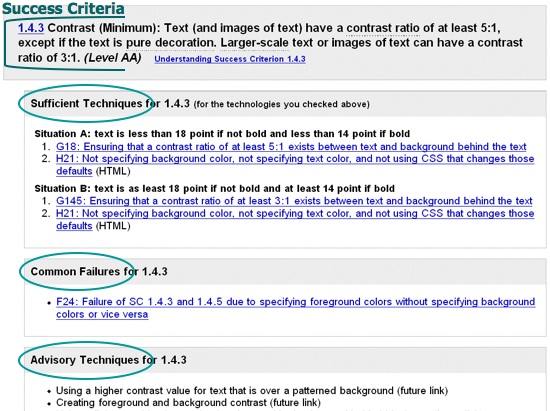World Wide Web Consortium (W3C)
"Leading the Web to its full potential"
- International, vendor-neutral consortium
- Multi-stakeholder, consensus process
- Open and royalty-free Web standards:
- HTML, CSS, XML, SVG, SMIL, ...
- Operates from MIT, ERCIM, and Keio
Web Accessibility Initiative (WAI)
WAI develops strategies, guidelines, resources to make the Web accessible:
- Accessibility support in W3C technologies
- Guidelines for implementing accessibility
- Methods for evaluating accessibility
- Conducting education and outreach
- Coordinating with Research and Development
What is Web Accessibility?
Web accessibility means that people with disabilities can use the Web
- Access to information and content
- Access to functions and controls
- Equal interaction and participation
Human right – UN Convention on the Rights of Persons with Disabilities (UNCRPD)
Web Accessibility Barriers
Examples of barriers on the Web include:
- Images, videos, audio with no alternative text
- Layout and font do not expand and shrink well
- Forms and controls can not be used by keyboard
- Inconsistent and/or overly complex navigation
- Script events are device and browser dependent
- User control, natural language, ...
Impact of Web Accessibility
Web accessibility also benefits many other users, with and without disabilities:
- Ageing-related limitations
- Low literacy or computer skills
- Temporal functional limitations
- Situation or external influence
- Limited bandwidth connectivity
- Legacy hardware and software
- Mobile and PDA technology
Over 65% can benefits from accessibility (Microsoft)
Business Benefits
Web accessibility is also a market opportunity:
- Increase audience reach and market share
- Reduce maintenance and redesign costs
- Increase server and bandwidth efficiency
- Support older and newer technologies
- Improve the access for mobile Web users
Scope of Web Accessibility
Web accessibility is supported by several key components:
- Base Format - technologies such as (X)HTML, CSS, SVG, SMIL, PDF, Flash, Silverlight, ...
- Authoring Tools - code editors, CMS, blog, wiki, save-as tools, conversion tools, ...
- User Agents - Web browsers, media players, browser plug-ins, assisitive technology, ...
- Web Content - text, images, audio, video, code, markup, structure, presentation, ...
Components of Web Accessibility

Example: Requirement
An example requirement from WCAG:
- provide a text equivalent for every non-text element
WAI Accessibility Guidelines
W3C Web Accessibility Initiative (WAI) develops and maintains:
Also:
Example: Workflow

Introducing WCAG 2.0
Web Content Accessibility Guidelines (WCAG) 2.0
- W3C Web standard since 11 December 2008
- Technology-independent
- Objectively testable
- Flexible for situations
- Support for developers
WCAG 2.0 - Structure
- Principles (4)
- Guidelines (12)
- Success Criteria - Level A (25)
- Success Criteria - Level AA (13)
- Success Criteria - Level AAA (23)
Note: WCAG 1.0 had 14 Guidelines and 65 Checkpoints
WCAG 2.0 - Principles
"POUR accessibility with WCAG 2.0":
- Perceivable
- Operable
- Understandable
- Robust
WCAG 2.0 - Guidelines
Examples of WCAG 2.0 Guidelines:
WCAG 2.0 - Success Criteria
Examples of WCAG 2.0 Success Criteria:
- 2.1.3 Keyboard (No Exception): All functionality of the content is operable through a keyboard interface without requiring specific timings for individual keystrokes - Level AAA
- 3.3.1 Error Identification: If an input error is automatically detected, the item that is in error is identified and the error is described to the user in text - Level A
WCAG 2.0 Techniques
Techniques provide guidance on applying WCAG 2.0:
- Sufficient Techniques - minimum requirements
- Advisory Techniques - additional improvements
- Common Failures - often encountered mistakes
Techniques are technology-specific (e.g. HTML, CSS, Scripting, PDF, Flash, Silverlight, ...)
WCAG 2.0 - Dynamic Checklist

Steps to Implementation
- Learn the basics – understand how people with disabilities interact with the Web
- Make an initial assessment of your site
- Set realistic targets and milestones
- Involve users from the very beginning
- Consider acquiring external expertise
- Test early and throughout, also with users
- Use the standards to help you throughout
Summary and Conclusion
- Web accessibility has benefits for everyone
- Web accessibility relies on key components
- Accessible authoring tools are essential
- WCAG 2.0 provides many improvements
- Little or no changes for Level AA websites
- Web applications can be made accessible
- Work with and learn from the real users
